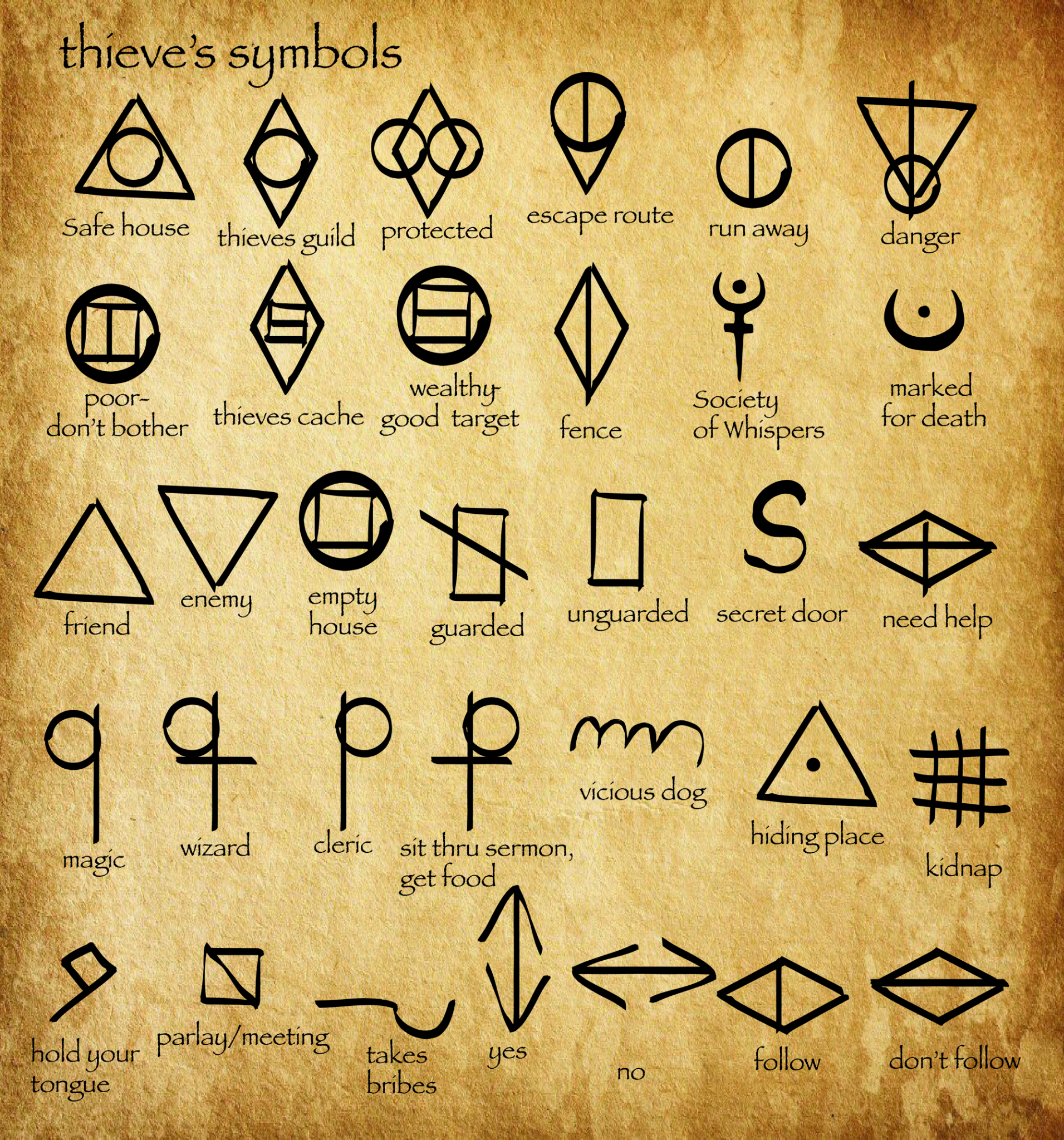5 Character Classes
The available classes are Cleric, Druid, Fighter, Paladin, Ranger, Magic-User, and Thief. To be a member of a class, a character must meet the specified Prime Requisite minimum and racial requirements for that class.
| Class | Minimum Scores |
|---|---|
| Cleric or Druid | Wisdom 9 |
| Figther | Strength 9 |
| Ranger | Strength 9, Wisdom 11, Dexterity 11 |
| Paladin | Strength 9, Wisdom 11, Charisma 11 |
| Magic-User | Intelligence 9 |
| Thief | Dexterity 9 |
| Fighter/Magic-User | Strength 9, Intelligence 9 |
| Magic-User/Thief | Intelligence 9, Dexterity 9 |
Cleric

Clerics have devoted themselves to the service of a deity. Additionally, there are twelve demigods and twelve Demon Lords. Clerics of demigods and Demon Lords cannot advance beyond 6th level.
Most Clerics spend their time in mundane forms of service, such as preaching and ministering at a temple. A select few are called to travel away from the temple and serve their deity more directly, smiting undead monsters and aiding in the battle against evil and chaos. Player Clerics are assumed to be among this group.
Clerics fight about as well as Thieves but not as well as Fighters. They are hardier than Thieves, at least at lower levels, as they are accustomed to physical labor that the Thief would deftly avoid. Clerics can cast spells of divine nature starting at 2nd level, and they have the power to Turn the Undead, driving away undead monsters by means of faith alone (see the Encounter section for details).
The Prime Requisite for Clerics is Wisdom; a character must have a Wisdom score of 9 or higher to become a Cleric. They may wear any armor and have no weapon restrictions.
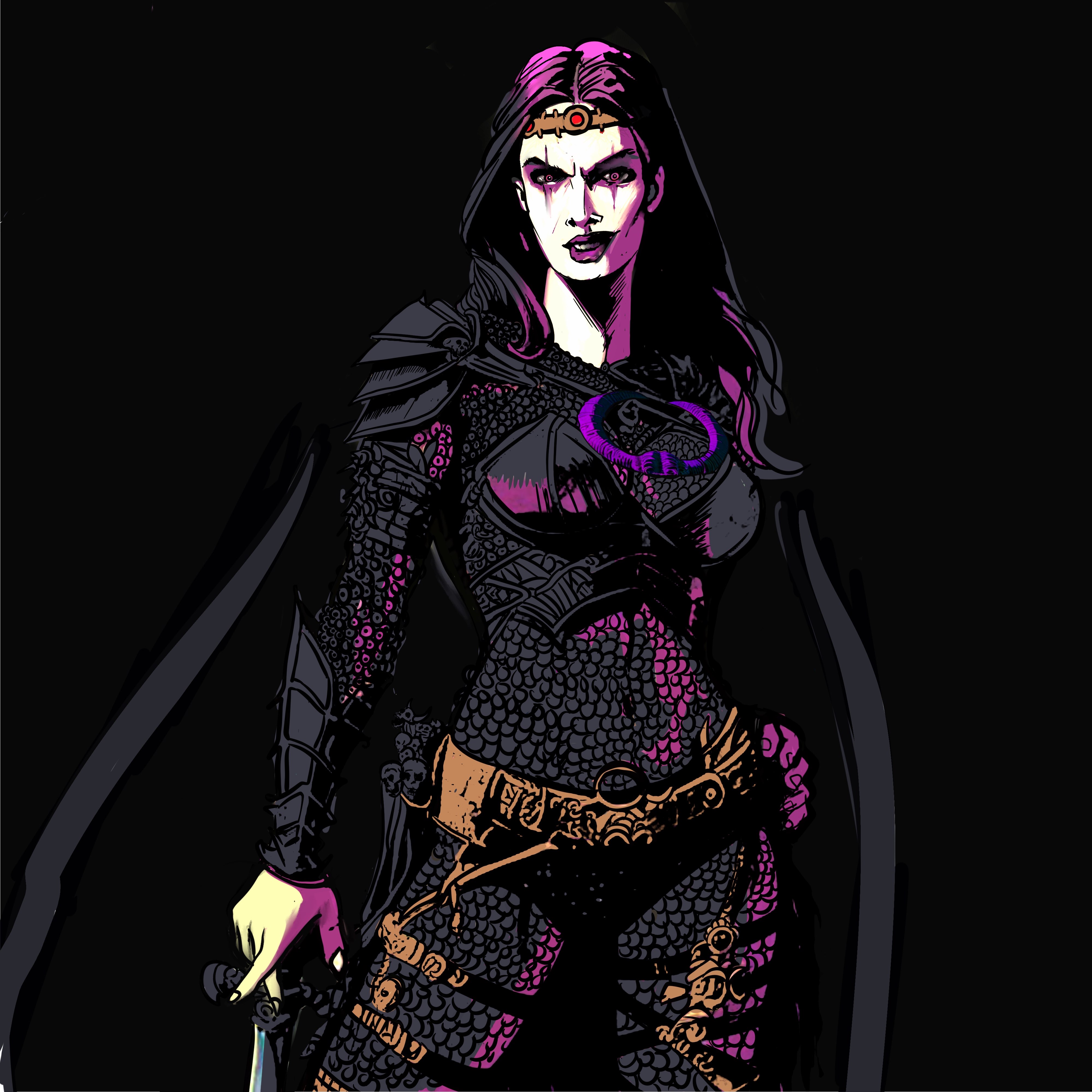
| Spell Level | ||||||||||||||
|---|---|---|---|---|---|---|---|---|---|---|---|---|---|---|
| Level | Exp. Points | Hit Dice | Attack Bonus |
Skill Points |
Feats | 0 | 1 | 2 | 3 | 4 | 5 | 6 | 7 | Weapon Proficiency |
| 1 | 0 | 1d8 | +1 | 3 | 1 | – | – | – | – | – | – | – | 3 | |
| 2 | 1,500 | 2d8 | +1 | 1 | 1 | 2 | 1 | – | – | – | – | – | – | |
| 3 | 3,000 | 3d8 | +2 | 1 | 3 | 2 | – | – | – | – | – | – | ||
| 4 | 6,000 | 4d8 | +2 | 1 | 1 | 4 | 2 | 1 | – | – | – | – | – | 1 |
| 5 | 12,000 | 5d8 | +3 | 1 | 5 | 2 | 2 | – | – | – | – | – | ||
| 6 | 24,000 | 6d8 | +3 | 1 | 1 | 6 | 2 | 2 | 1 | – | – | – | – | |
| 7 | 48,000 | 7d8 | +4 | 1 | 7 | 3 | 2 | 2 | – | – | – | – | 1 | |
| 8 | 90,000 | 8d8 | +4 | 1 | 1 | 8 | 3 | 2 | 2 | 1 | – | – | – | |
| 9 | 180,000 | 9d8 | +5 | 1 | 9 | 3 | 3 | 2 | 2 | – | – | – | ||
| 10 | 270,000 | 9d8+1 | +5 | 1 | 1 | 9 | 3 | 3 | 2 | 2 | 1 | – | – | 1 |
| 11 | 360,000 | 9d8+2 | +5 | 1 | 9 | 4 | 3 | 3 | 2 | 2 | – | – | ||
| 12 | 450,000 | 9d8+3 | +6 | 1 | 1 | 9 | 4 | 4 | 3 | 2 | 2 | 1 | – | |
| 13 | 540,000 | 9d8+4 | +6 | 1 | 9 | 4 | 4 | 3 | 3 | 2 | 2 | – | 1 | |
| 14 | 630,000 | 9d8+5 | +6 | 1 | 1 | 9 | 4 | 4 | 4 | 3 | 2 | 2 | 1 | |
| 15 | 720,000 | 9d8+6 | +7 | 1 | 9 | 4 | 4 | 4 | 3 | 3 | 2 | 1 | ||
| 16 | 810,000 | 9d8+7 | +7 | 1 | 1 | 9 | 5 | 4 | 4 | 3 | 3 | 2 | 1 | 1 |
| 17 | 900,000 | 9d8+8 | +7 | 1 | 9 | 5 | 5 | 4 | 3 | 3 | 2 | 2 | ||
| 18 | 990,000 | 9d8+9 | +8 | 1 | 1 | 9 | 5 | 5 | 4 | 4 | 3 | 3 | 2 | |
| 19 | 1,080,000 | 9d8+10 | +8 | 1 | 9 | 6 | 5 | 4 | 4 | 3 | 3 | 2 | 1 | |
| 20 | 1,170,000 | 9d8+11 | +8 | 1 | 1 | 9 | 6 | 5 | 4 | 4 | 3 | 3 | 3 | |
| Wisdom | Spell Bonus |
|---|---|
| 9-11 | No bonus spells |
| 12 | +1 Orison |
| 13-15 | +1 Orison, +1 1st level spell |
| 16-17 | +2 Orisons, +2 1st level spells |
| 18 | +3 Orisons, +3 1st level, +1 2nd level spells |
| Alignment | Level 1 | Level 2 | Level 3 | Level 4 | Level 5 | Level 9 | Level 12 | Level 15 |
|---|---|---|---|---|---|---|---|---|
| Lawful | Acolyte | Adept | Priest | Vicar | Curate | High Priest | Bishop | Patriarch/Matriarch |
| Neutral | Seeker | Devotee | Guardian | Shaman | Guide | Elder | Hierarch | Oracle |
| Chaotic | Initiate | Zealot | Cultist | Ravager | Doomcaller | Blightbringer | Shadow Prophet | Chaos Lord/Lady |
| Level | Death Ray / Poison | Magic Wands | Paralysis / Petrify | Dragon Breath | Spells |
|---|---|---|---|---|---|
| 1 | 11 | 12 | 14 | 16 | 15 |
| 2-3 | 10 | 11 | 13 | 15 | 14 |
| 4-5 | 9 | 10 | 13 | 15 | 14 |
| 6-7 | 9 | 10 | 12 | 14 | 13 |
| 8-9 | 8 | 9 | 12 | 14 | 13 |
| 10-11 | 8 | 9 | 11 | 13 | 12 |
| 12-13 | 7 | 8 | 11 | 13 | 12 |
| 14-15 | 7 | 8 | 10 | 12 | 11 |
| 16-17 | 6 | 7 | 10 | 12 | 11 |
| 18-19 | 6 | 7 | 9 | 11 | 10 |
| 20 | 5 | 6 | 9 | 11 | 10 |
Turning the Undead
Clerics can Turn undead, that is, drive away undead monsters by means of faith alone. The Cleric brandishes their holy symbol and calls upon the power of their divine patron. The player rolls 1d20 and adds their Wisdom Bonus.
If the table indicates “No”, it is not possible for the Cleric to affect that type of undead monster. If the table gives a number, that is the minimum number needed on 1d20 to Turn. Areas indicating “T” indicate that this type of undead is automatically affected. If the result shown is a “D,” then the undead is destroyed rather than merely Turned.
If the roll is a success, 2d6 + Wis hit dice of undead monsters are affected. Surplus hit dice are lost (so if zombies are being Turned and a roll of 7 is made, at most 3 zombies can be Turned), but a minimum of one creature will always be affected if the first roll succeeds.
If a mixed group of undead is to be Turned, the result is checked against the weakest first.
If a Cleric succeeds at Turning the undead, but not all undead monsters present are affected, they may try again in the next round to turn any remaining undead. If any roll to Turn the Undead fails, that Cleric may not attempt to Turn Undead again for one full turn. A partial failure (possible against a mixed group) counts as a failure for this purpose. Turned Undead monsters flee from the Cleric at maximum movement. If the party pursue and corner the Turned undead, they may resume attacking the party; but if left alone, the monsters will not return or attempt to attack the Cleric or those near them for at least 2d4 turns.
Undead monsters subject to a D (Damaged) result suffer 1d8 damage per level of the Cleric (roll once and apply the same damage to all undead monsters affected); those reduced to zero hit points are utterly destroyed, being blasted into little fiery embers and ash. Those surviving this damage are still Turned as above.
Note: Evil clerics can choose to command Undead rather than turn them.
| Cleric Lvl | Skeleton | Zombie | Ghoul | Wight | Wraith | Mummy | Spectre | Vampire | Ghost |
|---|---|---|---|---|---|---|---|---|---|
| 1 HD | 2 HD | 3 HD | 4 HD | 5 HD | 6 HD | 7 HD | 8 HD | 9+ HD | |
| 1 | 13 | 17 | 19 | No | No | No | No | No | No |
| 2 | 11 | 15 | 18 | 20 | No | No | No | No | No |
| 3 | 9 | 13 | 17 | 19 | No | No | No | No | No |
| 4 | 7 | 11 | 15 | 18 | 20 | No | No | No | No |
| 5 | 5 | 9 | 13 | 17 | 19 | No | No | No | No |
| 6 | 3 | 7 | 11 | 15 | 18 | 20 | No | No | No |
| 7 | 2 | 5 | 9 | 13 | 17 | 19 | No | No | No |
| 8 | T | 3 | 7 | 11 | 15 | 18 | 20 | No | No |
| 9 | T | 2 | 5 | 9 | 13 | 17 | 19 | No | No |
| 10 | T | T | 3 | 7 | 11 | 15 | 18 | 20 | No |
| 11 | D | T | 2 | 5 | 9 | 13 | 17 | 19 | No |
| 12 | D | T | T | 3 | 7 | 11 | 15 | 18 | 20 |
| 13 | D | D | T | 2 | 5 | 9 | 13 | 17 | 19 |
| 14 | D | D | T | T | 3 | 7 | 11 | 15 | 18 |
| 15 | D | D | D | T | 2 | 5 | 9 | 13 | 17 |
| 16 | D | D | D | T | T | 3 | 7 | 11 | 15 |
| 17 | D | D | D | D | T | 2 | 5 | 9 | 13 |
| 18 | D | D | D | D | T | T | 3 | 7 | 11 |
| 19 | D | D | D | D | D | T | 2 | 5 | 9 |
| 20 | D | D | D | D | D | T | T | 3 | 7 |
Druids
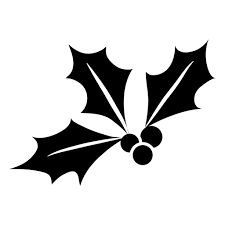
Druids are nature priests, revering the gods of the natural world. They are a hybrid of Magic-User and Cleric, drawing power from nature and ley lines, and revering all the gods of OnceWas as well as elemental forces. Druids serve the natural order in a more direct way by working actively to restore balance. Often, a Druid uses mistletoe as a holy symbol, but this can vary with specific nature deities. Druids spend their time contemplating nature or in mundane forms of service such as ministering in rural areas. However, some are called to go abroad to serve the natural order more directly by working actively to restore balance.
Druids advance at the same rate as Clerics but use the same combat and saving throw tables as Magic-Users. Druids can cast spells of divine nature starting at 2nd level, and they have the power of Animal Affinity (detailed at the end), working much like the Clerical ability to Turn Undead. They can identify any natural animal or plant and can identify clean water.
The Prime Requisite for Druid is Wisdom; a character must have a Wisdom score of 9 or higher to become a Druid. Druids may not utilize metal armor of any type, and they are likewise limited to wooden shields. Druids utilize any one-handed melee weapon, as well as staff, sling, and shortbow.
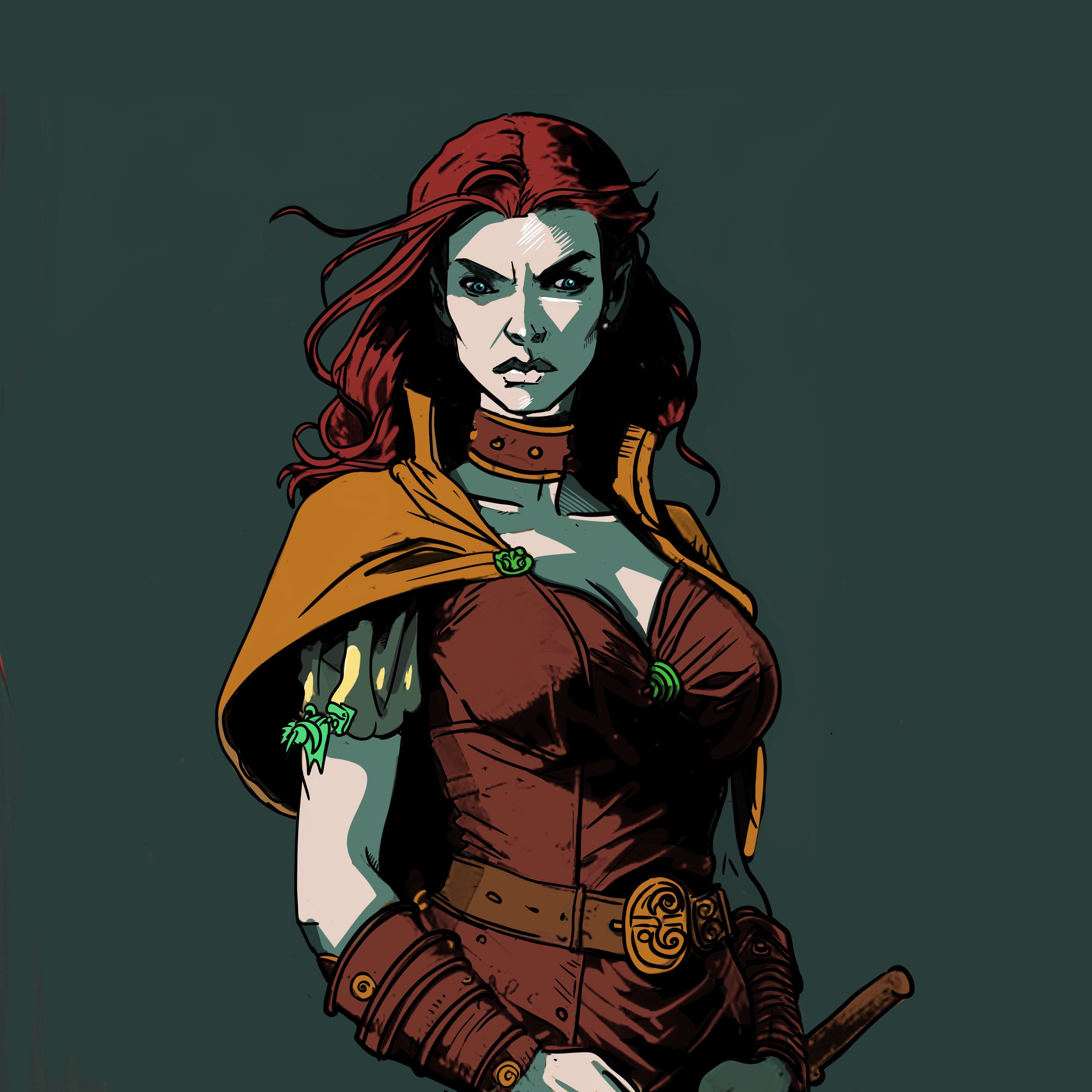
| Spell Level | ||||||||||||||
|---|---|---|---|---|---|---|---|---|---|---|---|---|---|---|
| Level | Exp. Points | Hit Dice | Attack Bonus |
Skill Points |
Feats | 0 | 1 | 2 | 3 | 4 | 5 | 6 | 7 | Weapon Proficiency |
| 1 | 0 | 1d6 | +1 | 3 | 1 | – | – | – | – | – | – | – | 3 | |
| 2 | 1,500 | 2d6 | +1 | 1 | 1 | 2 | 1 | – | – | – | – | – | – | |
| 3 | 3,000 | 3d6 | +1 | 1 | 3 | 2 | – | – | – | – | – | – | ||
| 4 | 6,000 | 4d6 | +2 | 1 | 1 | 4 | 2 | 1 | – | – | – | – | – | |
| 5 | 12,000 | 5d6 | +2 | 1 | 5 | 2 | 2 | – | – | – | – | – | 1 | |
| 6 | 24,000 | 6d6 | +3 | 1 | 1 | 6 | 2 | 2 | 1 | – | – | – | – | |
| 7 | 48,000 | 7d6 | +3 | 1 | 7 | 3 | 2 | 2 | – | – | – | – | ||
| 8 | 90,000 | 8d6 | +3 | 1 | 1 | 8 | 3 | 2 | 2 | 1 | – | – | – | |
| 9 | 180,000 | 9d6 | +4 | 1 | 9 | 3 | 3 | 2 | 2 | – | – | – | 1 | |
| 10 | 270,000 | 9d6+1 | +4 | 1 | 1 | 9 | 3 | 3 | 2 | 2 | 1 | – | – | |
| 11 | 360,000 | 9d6+2 | +4 | 1 | 9 | 4 | 3 | 3 | 2 | 2 | – | – | ||
| 12 | 450,000 | 9d6+3 | +4 | 1 | 1 | 9 | 4 | 4 | 3 | 2 | 2 | 1 | – | |
| 13 | 540,000 | 9d6+4 | +5 | 1 | 9 | 4 | 4 | 3 | 3 | 2 | 2 | – | 1 | |
| 14 | 630,000 | 9d6+5 | +5 | 1 | 1 | 9 | 4 | 4 | 4 | 3 | 2 | 2 | 1 | |
| 15 | 720,000 | 9d6+6 | +5 | 1 | 9 | 4 | 4 | 4 | 3 | 3 | 2 | 1 | ||
| 16 | 810,000 | 9d6+7 | +6 | 1 | 1 | 9 | 5 | 4 | 4 | 3 | 3 | 2 | 1 | |
| 17 | 900,000 | 9d6+8 | +6 | 1 | 9 | 5 | 5 | 4 | 3 | 3 | 2 | 2 | 1 | |
| 18 | 990,000 | 9d6+9 | +6 | 1 | 1 | 9 | 5 | 5 | 4 | 4 | 3 | 3 | 2 | |
| 19 | 1,080,000 | 9d6+10 | +7 | 1 | 9 | 6 | 5 | 4 | 4 | 3 | 3 | 2 | ||
| 20 | 1,170,000 | 9d6+11 | +7 | 1 | 1 | 9 | 6 | 5 | 4 | 4 | 3 | 3 | 3 | |
| Wisdom | Spell Bonus |
|---|---|
| 9-11 | No bonus spells |
| 12 | +1 Orison |
| 13-15 | +1 Orison, +1 1st level spell |
| 16-17 | +2 Orisons, +2 1st level spells |
| 18 | +3 Orisons, +3 1st level, +1 2nd level spells |
| Druid Level | 1st | 2nd | 3rd | 4th | 5th | 9th | 12th | 15th |
|---|---|---|---|---|---|---|---|---|
| Rank/Title | Aspirant | Initiate | Wayfarer | Grovekeeper | Warden | Herald | Spring Walker | Elder Druid |
| Level | Death Ray / Poison | Magic Wands | Paralysis / Petrify | Dragon Breath | Spells |
|---|---|---|---|---|---|
| 1 | 13 | 14 | 13 | 16 | 15 |
| 2-3 | 13 | 14 | 13 | 15 | 14 |
| 4-5 | 12 | 13 | 12 | 15 | 13 |
| 6-7 | 12 | 12 | 11 | 14 | 13 |
| 8-9 | 11 | 11 | 10 | 14 | 12 |
| 10-11 | 11 | 10 | 9 | 13 | 11 |
| 12-13 | 10 | 10 | 9 | 13 | 11 |
| 14-15 | 10 | 9 | 8 | 12 | 10 |
| 16-17 | 9 | 8 | 7 | 12 | 9 |
| 18-19 | 9 | 7 | 6 | 11 | 9 |
| 20 | 8 | 6 | 5 | 11 | 8 |
Animal Affinity
Druids can calm or befriend animals. The Druid rolls a d20 and adds their Wisdom Bonus. Cross-reference the Druid’s level with the animal’s hit dice on the Druids Animal Affinity Table. The number shown is the minimum needed to Calm that sort of animal. Tame, Domesticated, or Normal Beasts of Burden are treated as half their actual Hit Dice, reflecting their relatively easy manageability. Monstrous animals such as griffins, owlbears, pegasi, or other such “near-natural” creatures are treated as they are 1 HD more than listed to reflect their unique natures.
If the table indicates “No” then it is not possible for the Druid to affect that type of animal. If the table says “C” for that combination, that type of animal is automatically calmed. If the result shown is a “B” for that combination, that type of animal is automatically befriended. If the roll is a success, 2d6 HD of animals is affected. Surplus hit dice are lost, but at least one animal is always affected if the first roll is a success. If a mixed group of animals is to be affected, the druid rolls just once. The result is checked against the weakest sort first and if they are successfully Calmed or Befriended, the same result is checked against the next higher type of animal.
If a Druid succeeds at Calming or Befriending some of the animals, but not all are affected, they may try again in the next round to affect those which remain. If any roll to Calm or Befriend the Animals fails, that Druid may not attempt to use their Animal Affinity ability again for one full turn. A partial failure (possible against a mixed group) counts as a failure for this purpose.
Calm animals will not interact with the Druid in any manner, unless approached by the Druid. The Druid can calmly get them to leave an area, or the Druid can try to befriend the animals. In this case, the DM should roll a reaction roll with any result below “uncertain” meaning the animals flee. If the result on the table results in automatically befriending the animals, the DM should treat the animals as if a “Friendly,” result was rolled on the Reaction Roll Table. A Befriended animal will follow the Druid, guarding and assisting within its capabilities so long as the Druid remains in the general vicinity of its normal lair or range. However, it will not fight to the death or sacrifice itself indiscriminately. When substantially wounded, an animal will flee the area immediately. The DM may check morale as necessary when the situation seems appropriate.
| Druid Lvl | < 1 HD | 1 HD | 2 HD | 3 HD | 4 HD | 5 HD | 6 HD | 7 HD | 8 HD | 9 HD | 10 HD |
|---|---|---|---|---|---|---|---|---|---|---|---|
| 1 | 9 | 13 | 17 | 19 | No | No | No | No | No | No | No |
| 2 | 7 | 11 | 15 | 18 | 20 | No | No | No | No | No | No |
| 3 | 5 | 9 | 13 | 17 | 19 | No | No | No | No | No | No |
| 4 | 3 | 7 | 11 | 15 | 18 | 20 | No | No | No | No | No |
| 5 | 2 | 5 | 9 | 13 | 17 | 19 | No | No | No | No | No |
| 6 | C | 3 | 7 | 11 | 15 | 18 | 20 | No | No | No | No |
| 7 | C | 2 | 5 | 9 | 13 | 17 | 19 | No | No | No | No |
| 8 | C | C | 3 | 7 | 11 | 15 | 18 | 20 | No | No | No |
| 9 | B | C | 2 | 5 | 9 | 13 | 17 | 19 | No | No | No |
| 10 | B | C | C | 3 | 7 | 11 | 15 | 18 | 20 | No | No |
| 11 | B | B | C | 2 | 5 | 9 | 13 | 17 | 19 | No | No |
| 12 | B | B | C | C | 3 | 7 | 11 | 15 | 18 | 20 | No |
| 13 | B | B | B | C | 2 | 5 | 9 | 13 | 17 | 19 | No |
| 14 | B | B | B | C | C | 3 | 7 | 11 | 15 | 18 | 20 |
| 15 | B | B | B | B | C | 2 | 5 | 9 | 13 | 17 | 19 |
| 16 | B | B | B | B | C | C | 3 | 7 | 11 | 15 | 18 |
| 17 | B | B | B | B | B | C | 2 | 5 | 9 | 13 | 17 |
| 18 | B | B | B | B | B | C | C | 3 | 7 | 11 | 15 |
| 19 | B | B | B | B | B | B | C | 2 | 5 | 9 | 13 |
| 20 | B | B | B | B | B | B | C | C | 3 | 7 | 11 |
Fighter

Fighters include soldiers, town guardsmen, barbarian warriors, and anyone else for whom fighting is a way of life. They train in combat, and they generally approach problems head on, weapon drawn. Not surprisingly, Fighters are the best at fighting of all the classes. They are also the hardiest, able to take more punishment than any other class.
The Prime Requisite for Fighters is Strength; a character must have a Strength score of 9 or higher to become a Fighter. Members of this class may wear any armor and use any weapon.
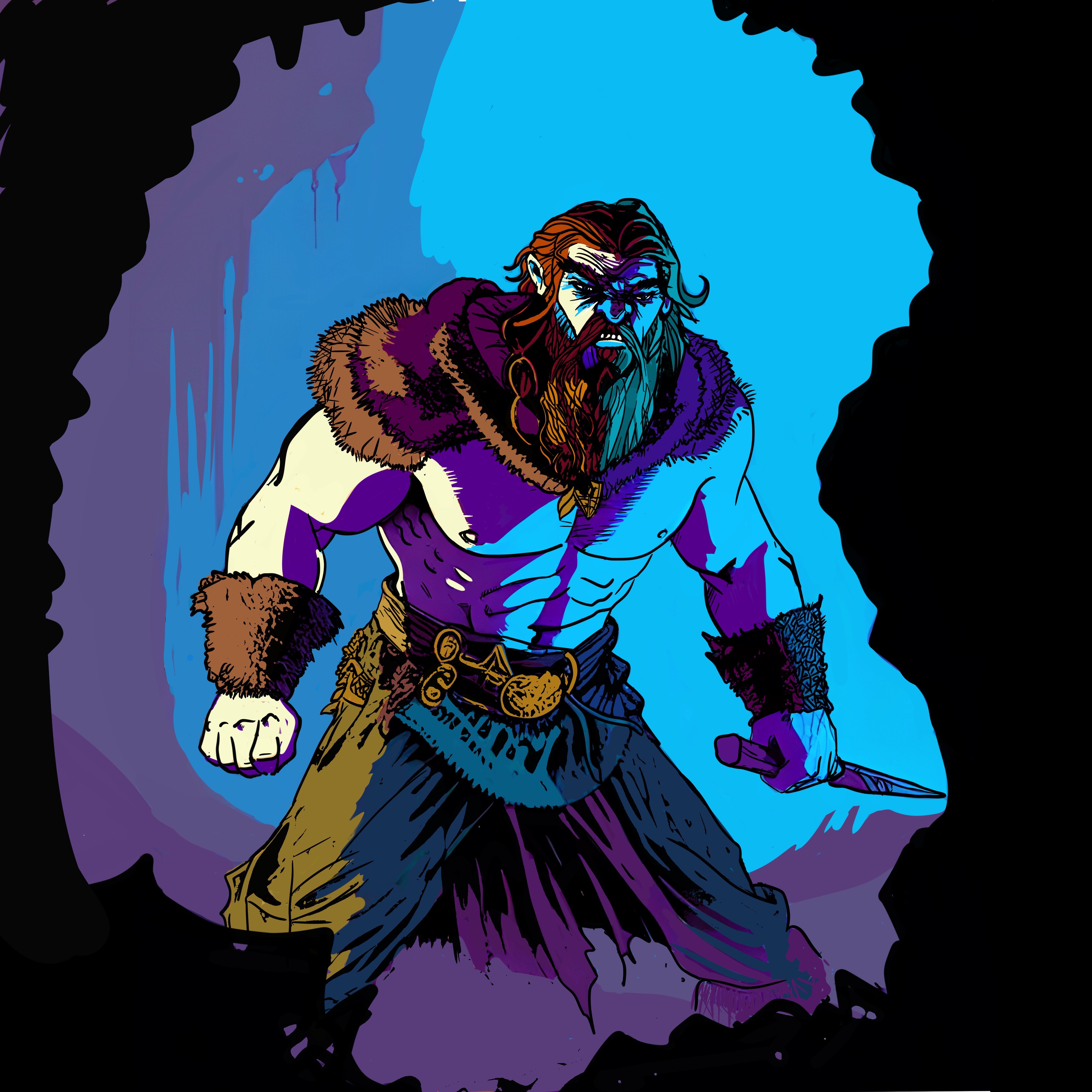
| Level | Exp. Points | Hit Dice | Attack Bonus | Attacks/ Round |
Weapon Specialization | Skill points | Feats | Weapon Proficiency |
|---|---|---|---|---|---|---|---|---|
| 1 | 0 | 1d10 | +1 | 1/1 | +1/+0 | 3 | 4 | |
| 2 | 2,000 | 2d10 | +2 | 1/1 | +1/+0 | 1 | 1 | |
| 3 | 4,000 | 3d10 | +2 | 1/1 | +1/+0 | 1 | 1 | |
| 4 | 8,000 | 4d10 | +3 | 1/1 | +1/+1 | 1 | 1 | |
| 5 | 16,000 | 5d10 | +4 | 1/1 | +1/+1 | 1 | 1 | |
| 6 | 32,000 | 6d10 | +4 | 1/1 | +1/+1 | 1 | 1 | |
| 7 | 64,000 | 7d10 | +5 | 3/2 | +2/+1 | 1 | 1 | |
| 8 | 120,000 | 8d10 | +6 | 3/2 | +2/+2 | 1 | 1 | |
| 9 | 240,000 | 9d10 | +6 | 3/2 | +2/+2 | 1 | 1 | |
| 10 | 360,000 | 9d10+2 | +6 | 3/2 | +2/+2 | 1 | 1 | |
| 11 | 480,000 | 9d10+4 | +7 | 3/2 | +2/+2 | 1 | 1 | |
| 12 | 600,000 | 9d10+6 | +7 | 3/2 | +2/+2 | 1 | 1 | |
| 13 | 720,000 | 9d10+8 | +8 | 2/1 | +3/+2 | 1 | 1 | |
| 14 | 840,000 | 9d10+10 | +8 | 2/1 | +3/+2 | 1 | 1 | |
| 15 | 960,000 | 9d10+12 | +8 | 2/1 | +3/+2 | 1 | 1 | |
| 16 | 1,080,000 | 9d10+14 | +9 | 2/1 | +3/+3 | 1 | 1 | |
| 17 | 1,200,000 | 9d10+16 | +9 | 2/1 | +3/+3 | 1 | 1 | |
| 18 | 1,320,000 | 9d10+18 | +10 | 3/1 | +3/+3 | 1 | 1 | |
| 19 | 1,440,000 | 9d10+20 | +10 | 3/1 | +3/+3 | 1 | 1 | |
| 20 | 1,560,000 | 9d10+22 | +10 | 3/1 | +3/+3 | 1 | 1 |
| Strength | Fighting Bonus |
|---|---|
| 9-12 | +0 to hit, +0 damage |
| 13-15 | +1 to hit, +1 damage |
| 16-17 | +2 to hit, +2 damage |
| 18 | +3 to hit, +3 damage |
| Alignment | Level 1 | Level 2 | Level 3 | Level 4 | Level 5 | Level 9 | Level 12 | Level 15 |
|---|---|---|---|---|---|---|---|---|
| Lawful | Squire | Sergeant | Cavalier | Knight | Captain | Commander | Thane | Lord/Lady |
| Neutral | Bravo | Duelist | Sellsword | Swordsmen | Swordsmaster | Vangaurd | Warchief | Chieftain |
| Chaotic | Brawler | Raider | Marauder | Ravager | Reaver | Warmonger | Warlord | Overlord |
| Level | Death Ray / Poison | Magic Wands | Paralysis / Petrify | Dragon Breath | Spells |
|---|---|---|---|---|---|
| NM | 13 | 14 | 15 | 16 | 18 |
| 1 | 12 | 13 | 14 | 15 | 17 |
| 2-3 | 11 | 12 | 14 | 15 | 16 |
| 4-5 | 11 | 11 | 13 | 14 | 15 |
| 6-7 | 10 | 11 | 12 | 14 | 15 |
| 8-9 | 9 | 10 | 12 | 13 | 14 |
| 10-11 | 9 | 9 | 11 | 12 | 13 |
| 12-13 | 8 | 9 | 10 | 12 | 13 |
| 14-15 | 7 | 8 | 10 | 11 | 12 |
| 16-17 | 7 | 7 | 9 | 10 | 11 |
| 18-19 | 6 | 7 | 8 | 10 | 11 |
| 20 | 5 | 6 | 8 | 9 | 10 |
Weapon Specialization
A Fighter chooses one weapon in which the character is especially skilled. This choice must be specific; for instance, a specialization in the longsword will give no bonuses when using a shortsword. The weapon specialization confers additional to hit and damage bonuses as the fighter progresses in rank.
Paladins and Rangers cannot specialize.
Paladin
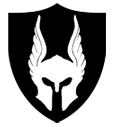
Paladins are the epitome of honor, courage, and righteousness, standing as beacons of hope against the growing darkness descending over the OnceWas. They are holy warriors, dedicated to upholding the tenets of justice and vanquishing evil wherever it may lurk. Blessed by divine powers, Paladins serve as champions of the gods, drawing upon their faith to perform miraculous feats and protect the innocent.
A character must a minimum Strength score of 9, a Wisdom score of 11, and a Charisma score of 11 to be a Paladin. Paladins must be human or half-even. They may use any weapon and may wear any armor or shield.
Paladins have the same attack bonus and saving throws as Fighters of the same level. They should be treated as Fighters for all purposes except they may not specialize.
| Spell Level | |||||||||||
|---|---|---|---|---|---|---|---|---|---|---|---|
| Level | Exp. Points | Hit Dice | Attack Bonus | Lay Hands | Skill Points | Feats | 0 | 1 | 2 | 3 | Weapon Proficiency |
| 1 | 0 | 1d10 | +1 | 1 | 3 | – | – | – | – | 3 | |
| 2 | 2,200 | 2d10 | +2 | 1 | 1 | 1 | – | – | – | – | |
| 3 | 4,400 | 3d10 | +2 | 2 | 1 | – | – | – | – | ||
| 4 | 8,800 | 4d10 | +3 | 2 | 1 | 1 | – | – | – | – | |
| 5 | 17,600 | 5d10 | +4 | 3 | 1 | 1 | – | – | – | 1 | |
| 6 | 35,200 | 6d10 | +4 | 3 | 1 | 1 | 1 | 1 | – | – | |
| 7 | 70,400 | 7d10 | +5 | 4 | 1 | 2 | 2 | – | – | ||
| 8 | 132,000 | 8d10 | +6 | 4 | 1 | 1 | 2 | 2 | 1 | – | |
| 9 | 264,000 | 9d10 | +6 | 5 | 1 | 2 | 2 | 2 | – | 1 | |
| 10 | 396,000 | 9d10+2 | +6 | 5 | 1 | 1 | 3 | 3 | 2 | – | |
| 11 | 528,000 | 9d10+4 | +7 | 6 | 1 | 3 | 3 | 3 | – | ||
| 12 | 660,000 | 9d10+6 | +7 | 6 | 1 | 1 | 3 | 4 | 3 | – | |
| 13 | 792,000 | 9d10+8 | +8 | 7 | 1 | 4 | 4 | 4 | – | 1 | |
| 14 | 924,000 | 9d10+10 | +8 | 7 | 1 | 1 | 4 | 5 | 4 | – | |
| 15 | 1,056,000 | 9d10+12 | +8 | 8 | 1 | 5 | 5 | 5 | – | ||
| 16 | 1,188,000 | 9d10+14 | +9 | 8 | 1 | 1 | 5 | 6 | 5 | – | |
| 17 | 1,320,000 | 9d10+16 | +9 | 9 | 1 | 5 | 6 | 5 | 1 | 1 | |
| 18 | 1,452,000 | 9d10+18 | +10 | 9 | 1 | 1 | 5 | 6 | 5 | 2 | |
| 19 | 1,584,000 | 9d10+20 | +10 | 10 | 1 | | 6 | 6 | 6 | 2 | |||
| 20 | 1,716,000 | 9d10+22 | +10 | 10 | 1 | 1 | 6 | 6 | 6 | 3 | |
Note starting at level 11 a Paladin may Lay Hands or Neutralize Poison the specified number of times per day.
| Paladin Level | 1st | 2nd | 3rd | 4th | 5th | 9th | 12th | 15th |
|---|---|---|---|---|---|---|---|---|
| Rank/Title | Squire | Initiate | Defender | Knight | Crusader | Champion | Holy Avenger | Paladin Lord |
| Level | Death Ray / Poison | Magic Wands | Paralysis / Petrify | Dragon Breath | Spells |
|---|---|---|---|---|---|
| NM | 13 | 14 | 15 | 16 | 18 |
| 1 | 12 | 13 | 14 | 15 | 17 |
| 2-3 | 11 | 12 | 14 | 15 | 16 |
| 4-5 | 11 | 11 | 13 | 14 | 15 |
| 6-7 | 10 | 11 | 12 | 14 | 15 |
| 8-9 | 9 | 10 | 12 | 13 | 14 |
| 10-11 | 9 | 9 | 11 | 12 | 13 |
| 12-13 | 8 | 9 | 10 | 12 | 13 |
| 14-15 | 7 | 8 | 10 | 11 | 12 |
| 16-17 | 7 | 7 | 9 | 10 | 11 |
| 18-19 | 6 | 7 | 8 | 10 | 11 |
| 20 | 5 | 6 | 8 | 9 | 10 |
Note Paladins save as a Fighter of the same level.
Paladin Abilities
Aura of Protection
Once per day, per level, Paladins emanate an aura of protection in a 10’ radius. All friendly creatures within range receive +2 bonus to AC and a +2 bonus on saves for 1 round/level of the Paladin.
Detect Evil
Once per day a Paladin may detect evil as the Detect Evil spell.
Holy Weapon
Once per day, per level, a Paladin can make their non-magical melee weapon or attack form equivalent to a magic weapon +1. This effect lasts for a turn.
Lay Hands
Once per day, the paladin can Lay on Hands to any wounded character and heal 2 points of damage; add the Paladin’s Charisma bonus to this figure. On each odd-numbered level (3rd, 5th, etc.) the Paladin may do this one additional time per day (so, twice per day at 3rd level, three times per day at 5th level, etc.) Starting at 7th level, the Paladin may choose to cure disease (as the spell) instead of providing healing as above. At 11th level, the Paladin may also neutralize poison.
Divine Magic
Starting at fifth level Paladins gain the ability to case Cleric Spells
Turn Undead
Starting ad 2nd level Paladins may Turn Undead.
| Paladin Lvl | Skeleton | Zombie | Ghoul | Wight | Wraith | Mummy | Spectre | Vampire | Ghost |
|---|---|---|---|---|---|---|---|---|---|
| 1 HD | 2 HD | 3 HD | 4 HD | 5 HD | 6 HD | 7 HD | 8 HD | 9+ HD | |
| 1 | – | – | – | – | – | – | – | – | – |
| 2 | 14 | 18 | 20 | No | No | No | No | No | No |
| 3 | 13 | 17 | 19 | No | No | No | No | No | No |
| 4 | 11 | 15 | 18 | 20 | No | No | No | No | No |
| 5 | 9 | 13 | 17 | 19 | No | No | No | No | No |
| 6 | 7 | 11 | 15 | 18 | 20 | No | No | No | No |
| 7 | 5 | 9 | 13 | 17 | 19 | No | No | No | No |
| 8 | 3 | 7 | 11 | 15 | 18 | 20 | No | No | No |
| 9 | 2 | 5 | 9 | 13 | 17 | 19 | No | No | No |
| 10 | T | 3 | 7 | 11 | 15 | 18 | 20 | No | No |
| 11 | T | 2 | 5 | 9 | 13 | 17 | 19 | No | No |
| 12 | T | T | 3 | 7 | 11 | 15 | 18 | 20 | No |
| 13 | D | T | 2 | 5 | 9 | 13 | 17 | 19 | No |
| 14 | D | T | T | 3 | 7 | 11 | 15 | 18 | 20 |
| 15 | D | D | T | 2 | 5 | 9 | 13 | 17 | 19 |
| 16 | D | D | T | T | 3 | 7 | 11 | 15 | 18 |
| 17 | D | D | D | T | 2 | 5 | 9 | 13 | 17 |
| 18 | D | D | D | T | T | 3 | 7 | 11 | 15 |
| 19 | D | D | D | D | T | 2 | 5 | 9 | 13 |
| 20 | D | D | D | D | T | T | 3 | 7 | 11 |
Paladin Restrictions
Tithe
A Paladin must tithe, giving a minimum of 10% of all treasures gained or other profits as an offering to their deity.
Code of Honor
A Paladin must obey a code of honor and strive to perform duties assigned by their deity or religious hierarchy. If the Paladin breaks the code, all granted powers are taken away, and the character must atone for their actions as soon as possible. Until the Paladin successfully atones, they are considered an ordinary Fighter
Ranger

Rangers roam the borderlands, where their mission is to keep the beasts and monsters of the untamed lands at bay. They generally operate alone or in small groups and rely on stealth and surprise to meet their objectives.
Humans, Elves, Half-Elves, and Halflings may become Rangers. To become a Ranger, a character must have a Strength score of 9 or higher, Wisdom of 11 or higher, and a Dexterity of 11 or higher. They may use any weapon and may wear any armor, but some of the Ranger’s special talents and abilities are unavailable when wearing armor heavier than leather armor.

| Level | Exp. Points | Hit Dice | Attack Bonus | Arrows Fired/Rd |
Skill Points |
Feats | Weapon Proficiency |
|---|---|---|---|---|---|---|---|
| 1 | 0 | 1d10 | +1 (+3 bow) | 1/1 | 3 | 4 | |
| 2 | 2,200 | 2d10 | +2 (+4 bow) | 1/1 | 1 | 1 | |
| 3 | 4,400 | 3 d10 | +2 (+5 bow) | 1/1 | 1 | 1 | |
| 4 | 8,800 | 4d10 | +3 (+6 bow) | 1/1 | 1 | 1 | |
| 5 | 17,600 | 5d10 | +4 (+7 bow) | 3/2 | 1 | 1 | |
| 6 | 35,200 | 6d10 | +4 (+7 bow) | 3/2 | 1 | 1 | |
| 7 | 70,400 | 7d10 | +5 (+8 bow) | 3/2 | 1 | 1 | |
| 8 | 132,000 | 8d10 | +6 (+9 bow) | 3/2 | 1 | 1 | |
| 9 | 264,000 | 9d10 | +6 (+9 bow) | 2/1 | 1 | 1 | |
| 10 | 396,000 | 9d10+2 | +6 (+9 bow) | 2/1 | 1 | 1 | |
| 11 | 528,000 | 9d10+4 | +7 (+10 bow) | 2/1 | 1 | 1 | |
| 12 | 660,000 | 9d10+6 | +7 (+10 bow) | 2/1 | 1 | 1 | |
| 13 | 792,000 | 9d10+8 | +8 (+11 bow) | 2/1 | 1 | 1 | |
| 14 | 924,000 | 9d10+10 | +8 (+11 bow) | 2/1 | 1 | 1 | |
| 15 | 1,056,000 | 9d10+12 | +8 (+11 bow) | 2/1 | 1 | 1 | |
| 16 | 1,188,000 | 9d10+14 | +9 (+12 bow) | 2/1 | 1 | 1 | |
| 17 | 1,320,000 | 9d10+16 | +9 (+12 bow) | 2/1 | 1 | 1 | |
| 18 | 1,452,000 | 9d10+18 | +10 (+13 bow) | 2/1 | 1 | 1 | |
| 19 | 1,584,000 | 9d10+20 | +10 (+13 bow) | 2/1 | 1 | 1 | |
| 20 | 1,716,000 | 9d10+22 | +10(+13 bow) | 2/1 | 1 | 1 |
| Alignment | Level 1 | Level 2 | Level 3 | Level 4 | Level 5 | Level 9 | Level 12 | Level 15 |
|---|---|---|---|---|---|---|---|---|
| Lawful | Tracker | Scout | Hunter | Pathfinder | Guardian | Ranger | Ranger Knight | Ranger Lord |
| Neutral | Wanderer | Seeker | Forager | Trailblazer | Warden | Outrider | Waykeeper | Forest Warden |
| Chaotic | Bandit | Stalker | Prowler | Nightblade | Manhunter | Darkstrider | Shadow Warden | Wildreaver |
| Level | Death Ray / Poison | Magic Wands | Paralysis / Petrify | Dragon Breath | Spells |
|---|---|---|---|---|---|
| 1 | 12 | 13 | 14 | 15 | 17 |
| 2-3 | 11 | 12 | 14 | 15 | 16 |
| 4-5 | 11 | 11 | 13 | 14 | 15 |
| 6-7 | 10 | 11 | 12 | 14 | 15 |
| 8-9 | 9 | 10 | 12 | 13 | 14 |
| 10-11 | 9 | 9 | 11 | 12 | 13 |
| 12-13 | 8 | 9 | 10 | 12 | 13 |
| 14-15 | 7 | 8 | 10 | 11 | 12 |
| 16-17 | 7 | 7 | 9 | 10 | 11 |
| 18-19 | 6 | 7 | 8 | 10 | 11 |
| 20 | 5 | 6 | 8 | 9 | 10 |
Ranger Abilities
Chosen Enemy
A Ranger must declare a chosen enemy. Against this chosen enemy, the Ranger gets a bonus of +3 to damage. This enemy must be specific such as giants, orcs, or dragons. It could also include rival organizations, nations, or similar agencies.
Expert Bowmen
Rangers are expert bowmen. When using any regular bow (shortbow or longbow, but not crossbow), a Ranger adds +2 to their Attack Bonus. At 5th level, a Ranger may fire three arrows every two rounds (a 3/2 rate of fire). This means one attack on every odd round and two attacks on every even round. At 9th level, the Ranger may fire two arrows every round, with the second attack coming at the end of the round.
Wilderness Expertise
Rangers can Move Silently, Hide, and Track when in wilderness areas, at percentages given in the table below. Apply a -2 penalty when attempting these abilities in urban areas. Move Silently and Hide may not be used in armor heavier than leather.
| Level | Move Silently (%) | Hide (%) | Track (%) |
|---|---|---|---|
| 1 | 20 | 20 | 30 |
| 2 | 25 | 25 | 35 |
| 3 | 30 | 30 | 40 |
| 4 | 35 | 35 | 45 |
| 5 | 40 | 40 | 50 |
| 6 | 45 | 45 | 55 |
| 7 | 50 | 50 | 60 |
| 8 | 55 | 55 | 65 |
| 9 | 60 | 60 | 70 |
| 10 | 65 | 65 | 75 |
| 11 | 70 | 70 | 80 |
| 12 | 75 | 75 | 85 |
| 13 | 80 | 80 | 90 |
| 14 | 85 | 85 | 95 |
| 15 | 90 | 90 | 100 |
Magic User
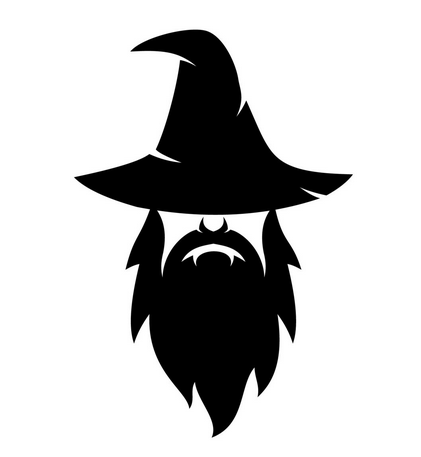
Magic users are scarce. They are just as frequently reviled as they are revered, often experiencing the shifting tides of popularity as political dynamics ebb and flow.
- Everyone knows that magic exists, but it is not typical in people’s daily lives.
- It is common among the working class to think that bad things tend to happen whenever magic is about.
- Magic items are uncommon — hidden away in deep dungeons or put on display as symbols of the owner’s power.
- Institutions of magic are rare outside of Glantri.
- Places of interest, cities, religious sites, concentrations of monsters, and wizard towers are all usually built on ley lines or high points.
Magic-Users seek and use knowledge of the arcane. They perform magic not as the Cleric does, by faith in a greater power, but rather through insight and understanding. Every Magic-User has a spellbook containing the magical formulae for each spell the Magic-User has learned. Spellbooks are written in the Arcane Language. All Magic-Users begin play knowing how to read, write, and speak Arcane.
Magic-Users are the worst of all the classes at fighting; hours spent studying massive tomes of magic do not lead a character to become strong or adept with weapons. They are the least hardy, equal to Thieves at lower levels but quickly falling behind.
The Prime Requisite for Magic-Users is Intelligence; a character must have an Intelligence score of 9 or higher to become a Magic-User. The only weapons they become proficient with are the dagger and the walking staff (or cudgel). Magic-Users may not wear armor of any sort nor use a shield as such things interfere with spellcasting.
A first-level Magic-User begins play knowing read magic and one other spell of first level. These spells are written in a spellbook provided by his or her master. The DM may roll for the spell, assign it as he or she sees fit, or allow the player to choose it, at his or her option. See the Spells section for more details.
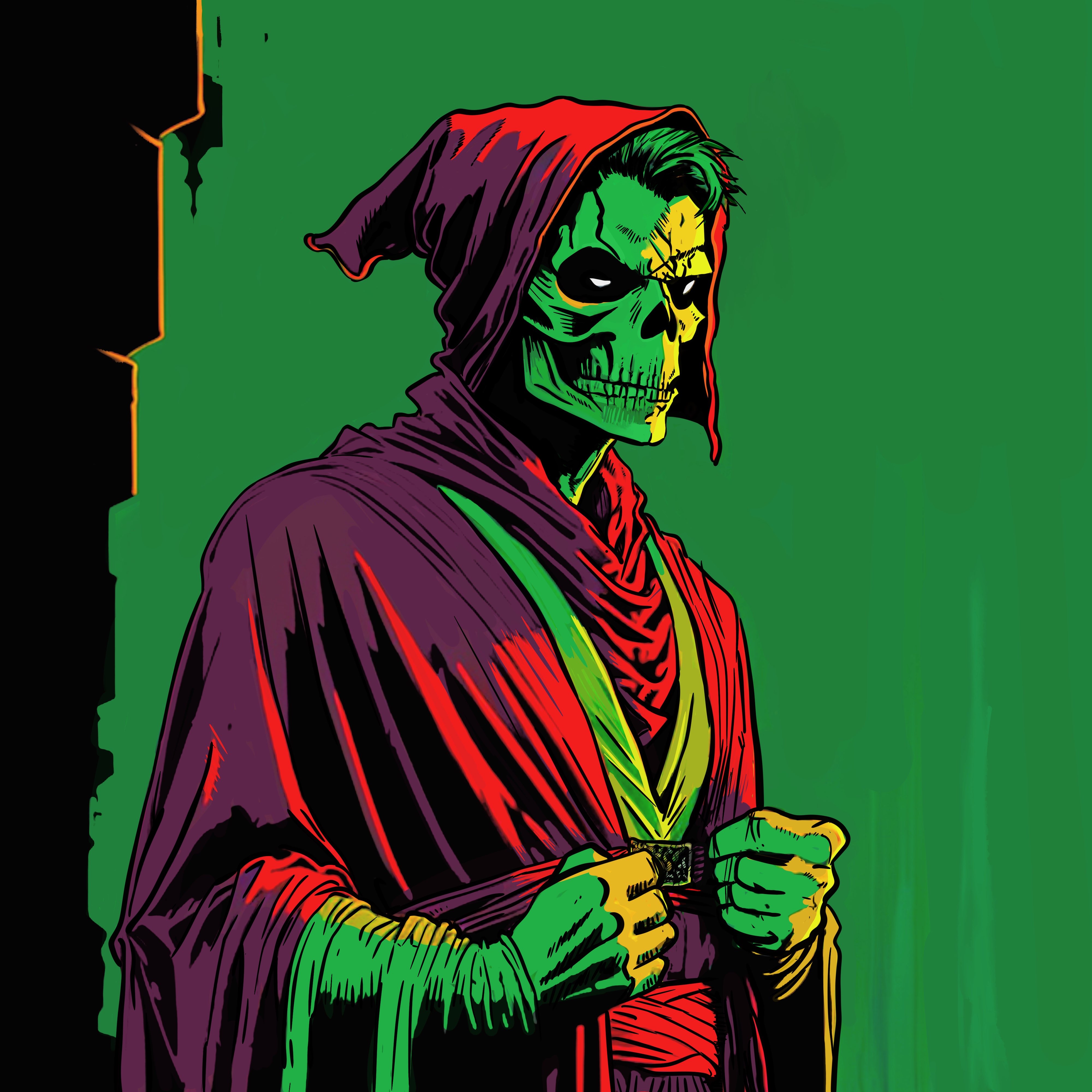
| Spell Level | ||||||||||||||
|---|---|---|---|---|---|---|---|---|---|---|---|---|---|---|
| Level | Exp. Points | Hit Dice | Attack Bonus | Skill Points | Feats | 0 | 1 | 2 | 3 | 4 | 5 | 6 | 7 | Weapon Proficiency |
| 1 | 0 | 1d4 | +1 | 3 | 1 | 1 | – | – | – | – | – | – | 2 | |
| 2 | 2,500 | 2d4 | +1 | 1 | 1 | 2 | 2 | – | – | – | – | – | – | |
| 3 | 5,000 | 3d4 | +1 | 1 | 3 | 2 | 1 | – | – | – | – | – | ||
| 4 | 10,000 | 4d4 | +2 | 1 | 1 | 4 | 2 | 2 | – | – | – | – | – | |
| 5 | 20,000 | 5d4 | +2 | 1 | 5 | 2 | 2 | 1 | – | – | – | – | ||
| 6 | 40,000 | 6d4 | +3 | 1 | 1 | 6 | 3 | 2 | 2 | – | – | – | – | |
| 7 | 80,000 | 7d4 | +3 | 1 | 7 | 3 | 2 | 2 | 1 | – | – | – | ||
| 8 | 150,000 | 8d4 | +3 | 1 | 1 | 8 | 3 | 3 | 2 | 2 | – | – | – | |
| 9 | 300,000 | 9d4 | +4 | 1 | 9 | 3 | 3 | 2 | 2 | 1 | – | – | ||
| 10 | 450,000 | 9d4+1 | +4 | 1 | 1 | 9 | 4 | 3 | 3 | 2 | 2 | – | – | |
| 11 | 600,000 | 9d4+2 | +4 | 1 | 9 | 4 | 4 | 3 | 2 | 2 | 1 | – | ||
| 12 | 750,000 | 9d4+3 | +4 | 1 | 1 | 9 | 4 | 4 | 3 | 3 | 2 | 2 | – | |
| 13 | 900,000 | 9d4+4 | +5 | 1 | 9 | 4 | 4 | 4 | 3 | 2 | 2 | 1 | ||
| 14 | 1,050,000 | 9d4+5 | +5 | 1 | 1 | 9 | 4 | 4 | 4 | 3 | 3 | 2 | 1 | |
| 15 | 1,200,000 | 9d4+6 | +5 | 1 | 9 | 5 | 4 | 4 | 3 | 3 | 2 | 1 | ||
| 16 | 1,350,000 | 9d4+7 | +6 | 1 | 1 | 9 | 5 | 5 | 4 | 3 | 3 | 2 | 2 | |
| 17 | 1,500,000 | 9d4+8 | +6 | 1 | 9 | 5 | 5 | 4 | 4 | 3 | 3 | 2 | ||
| 18 | 1,650,000 | 9d4+9 | +6 | 1 | 1 | 9 | 6 | 5 | 4 | 4 | 3 | 3 | 2 | |
| 19 | 1,800,000 | 9d4+10 | +7 | 1 | 9 | 6 | 5 | 5 | 4 | 3 | 3 | 2 | ||
| 20 | 1,950,000 | 9d4+11 | +7 | 1 | 1 | 9 | 6 | 5 | 5 | 4 | 4 | 3 | 3 | |
| Alignment | Level 1 | Level 2 | Level 3 | Level 4 | Level 5 | Level 9 | Level 12 | Level 15 |
|---|---|---|---|---|---|---|---|---|
| Lawful | Apprentice | Conjurer | Magician | Spellbinder | Arcanist | Wizard | Mage | Arch Mage |
| Neutral | Novice | Hedge Mage | Seer | Sage | Diviner | Magus | Mystagogue | Arch Magus |
| Chaotic | Warlock | Channeler | Hexcrafter | Spellbreaker | Chaosmancer | Sorcerer | Diabolist | Sorcerous Master |
| Intelligence | Spell Bonus |
|---|---|
| 9-11 | No bonus spells |
| 12 | +1 Cantrip |
| 13-15 | +1 Cantrip, +1 1st level spell |
| 16-17 | +2 Cantrips, +2 1st level spells |
| 18 | +3 Cantrips, +3 1st level, +1 2nd level spells |
| Level | Death Ray / Poison | Magic Wands | Paralysis / Petrify | Dragon Breath | Spells |
|---|---|---|---|---|---|
| 1 | 13 | 14 | 13 | 16 | 15 |
| 2-3 | 13 | 14 | 13 | 15 | 14 |
| 4-5 | 12 | 13 | 12 | 15 | 13 |
| 6-7 | 12 | 12 | 11 | 14 | 13 |
| 8-9 | 11 | 11 | 10 | 14 | 12 |
| 10-11 | 11 | 10 | 9 | 13 | 11 |
| 12-13 | 10 | 10 | 9 | 13 | 11 |
| 14-15 | 10 | 9 | 8 | 12 | 10 |
| 16-17 | 9 | 8 | 7 | 12 | 9 |
| 18-19 | 9 | 7 | 6 | 11 | 9 |
| 20 | 8 | 6 | 5 | 11 | 8 |
Magic-User Abilities
Starting Spells
A first level Magic-User begins play with inherent Detect Magic, Read Magic and Arcane Bolt. The player can also choose one 0 Level Spell and one 1 level Spell. The DM rolls any additional 0 and 1 spells randomly.
Inherent Detect Magic
Magic-Users can detect magic in anything they touch. Magical items or creatures feel warm, cause a tingling sensation, or have some other unusual tactile effect.
Inherent Read Magic
Magic-Users can read and write magic (Arcane) without a spell. The arcane language was discovered by Magic-Users (not invented). Arcane language is the same no matter what the native language or culture of the spell caster.
Arcane Bolt
This is a bolt of raw magic. The target gets a save vs. spells to avoid all damage. The bolt has a range of 30 feet and does 1d4 damage. Since it is pure magic, it will affect creatures only affected by magical weapons. The Arcane Bolt does not affect inanimate objects.
Spell Preparation
A Magic-User may only prepare spells after resting and needs one turn per each three spell levels to do so. Spells prepared but not used on a previous day are not lost. For example, a 3rd level Magic-User preparing all three of their available spells (two 1st level and one 2nd level) is preparing a total of 4 levels of spells, and thus needs 2 turns (4 divided by 3 and rounded up). Each day, usually in the morning, spellcasters prepare spells by studying their spellbooks to replace those they have used. Spells prepared but not used persist from day to day; only those cast must be replaced. A spellcaster may always choose to dismiss a prepared spell (without casting it) to prepare a different spell of that level.
Casting
Magic-Users must have at least one hand free and be able to speak to cast spells. Binding and gagging a spellcaster is an effective means of preventing spell casting. In combat, casting a spell takes the same time as making an attack
Spell Disruption
If a Magic-User is attacked (even if not hit), the character must make a saving throw vs. spells on the Initiative number on which they are casting a spell. On a failure, the spell is spoiled and lost. As a specific exception, two spell casters releasing their spells at each other on the same Initiative number will both succeed in their casting; one caster may disrupt another with a spell only if they have a better initiative and chooses to delay casting the spell until right before the other caster.
Learning New Spells
A Magic-User may learn spells by being taught directly by another magic user, by studying, by transcribing from a spell scroll or another individual’s spellbook, or through research. If being taught, a spell can be learned in a single day, while referencing another individual’s spellbook takes one day per spell level. It typically costs 300 gps per spell level.
To copy a spell, the character must spend 1d4 hours per Spell Level. The chance of successfully mastering a spell is DC 12 -1 per level of the magic-user, - INT bonus, +1 per level of the spell. Any failure requires another Magic-User who knows the spell to teach it. Spell mastery failure isn’t black and white. Spells that aren’t mastered may be cast but require a D20 check on the Potential Spell Failure Table.
| Roll | Effect |
|---|---|
| 1 | Spell fails entirely. A demon or other hostile entity appropriate to the setting appears and attacks the caster. |
| 2-4 | Spell fails entirely. Caster takes 1d6 points of injury. |
| 5-7 | Spell fails entirely. Caster temporarily forgets the spell. Make a DC10 Int roll after a week, and again each following week, until they remember. |
| 8-10 | Spell has the reverse of the intended effect. |
| 11-12 | Spell affects someone or something other than its intended target – friend, foe, or random object. |
| 13-14 | Spell produces nothing but a loud noise, bright flash of light, awful odor, etc. |
| 15-17 | Spell produces a weaker version of the intended effect. |
| 18-20 | Spell is cast normally. |
Great School of Magic in Glantri
The Great School of Magic in Glantri City is a place of arcane learning and the heart of Glantrian society. While many magic-users have been privately tutored, the best and brightest come from the Great School. There are 4 two-month quarters at the school separated by month long breaks. One on one mentoring continues until the Magic-User is 4th level at which point they are released to independent study. Routine testing is still administered until 6th level at which time the Magic-User graduates and is formally declared a Magic-User. After that time, they may stay at the school to use the facilities and take Arcana courses, but this is usually frowned upon.
Great School of Magic Costs and Expenses
The tuition for the Great School is 300 gp per spell level. One week is required per spell level to complete the research. Tuition covers access to the facilities, mentor, classes, and common needs such as ink and paper. Thrown in for free are a small room and three (poor) meals a day for those who want it.
Arcane Symbols
Magic-Users trained at Great School of Magic will be familar with the runes identifying potions created by the School’s Master Alchemist. Kappiyan Flurmastyr is the current Master Alchemist.
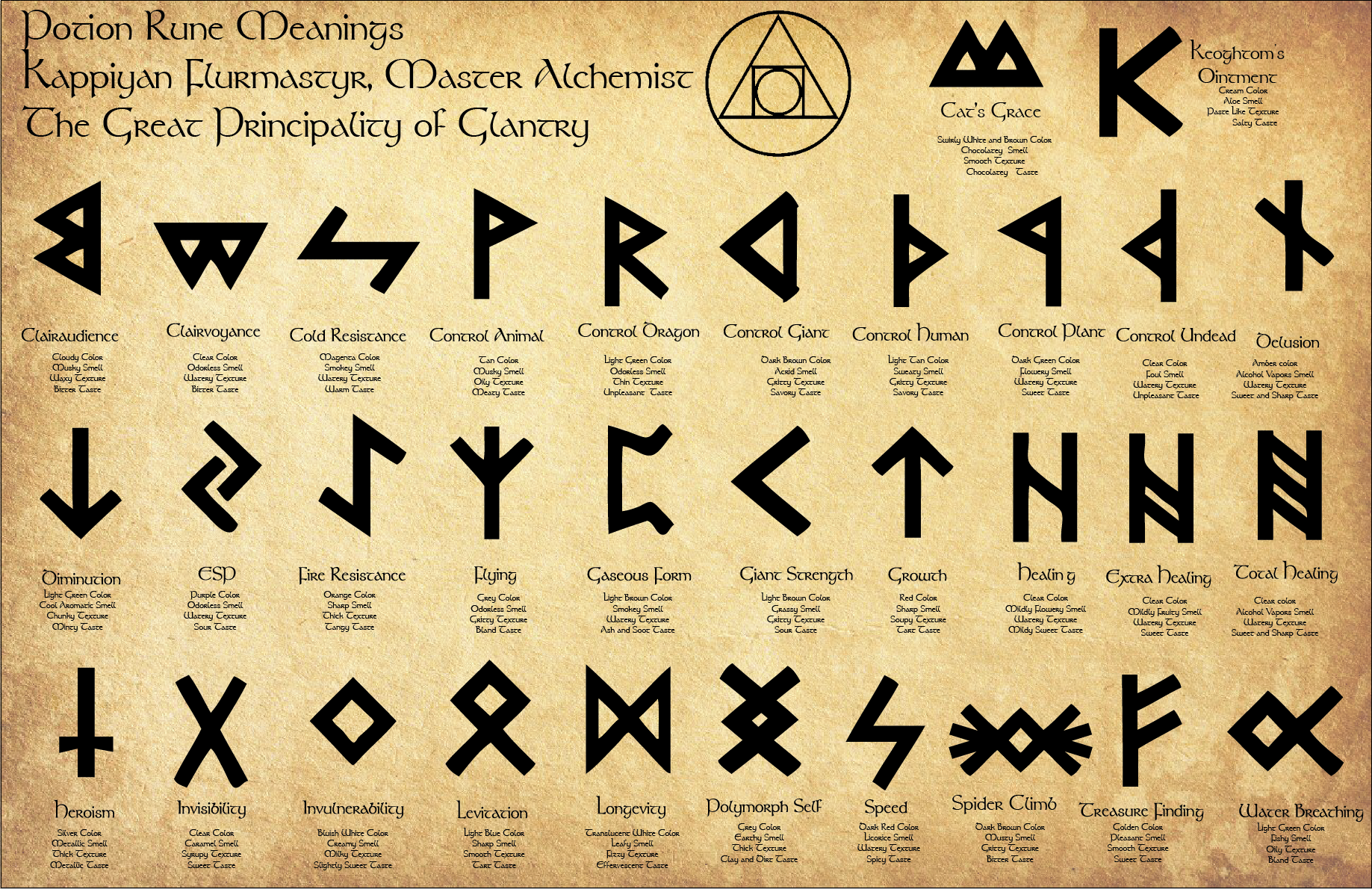
Magic-Users will also recognize certain arcane symbols representing the four basic elements.
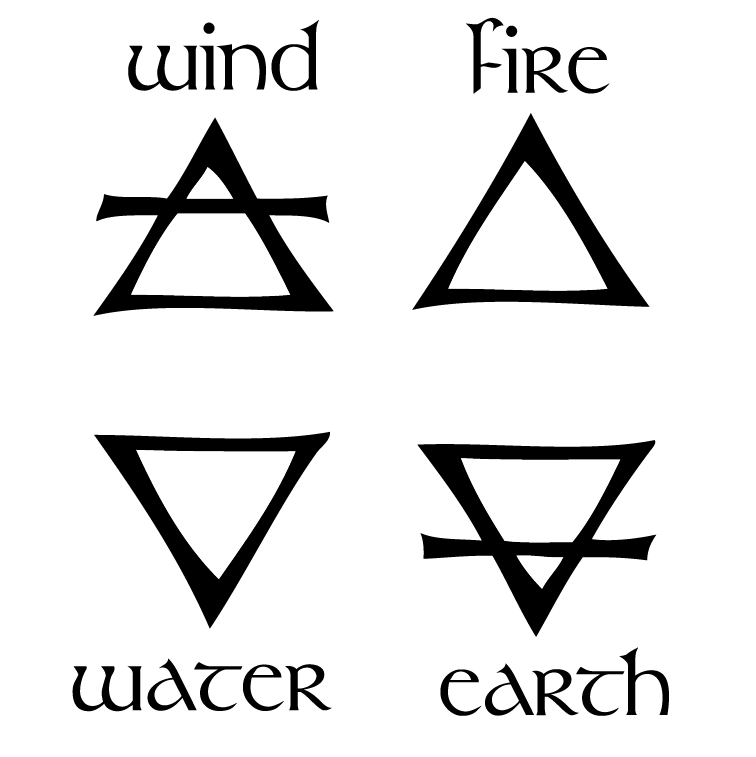
Thief

Thieves are those who take what they want or need by stealth, disarming traps and picking locks to get to the gold they crave; or “borrowing” money from pockets, beltpouches, etc. right under the nose of the “mark” without the victim ever knowing.
Thieves fight better than Magic-Users but not as well as Fighters. Avoidance of honest work leads Thieves to be less hardy than the other classes, though they do pull ahead of the Magic-Users at higher levels.

The Prime Requisite for Thieves is Dexterity; a character must have a Dexterity score of 9 or higher to become a Thief. They may use any weapon, but may not wear metal armor as it interferes with stealthy activities, nor may they use shields of any sort. Leather armor is acceptable, however.
| Level | Exp. Points | Hit Dice | Attack Bonus |
Skill Points |
Feats | Weapon Proficiency |
|---|---|---|---|---|---|---|
| 1 | 0 | 1d6 | +1 | 3 | 3 | |
| 2 | 1,250 | 2d6 | +1 | 1 | 1 | |
| 3 | 2,500 | 3d6 | +2 | 1 | ||
| 4 | 5,000 | 4d6 | +2 | 1 | 1 | 1 |
| 5 | 10,000 | 5d6 | +3 | 1 | ||
| 6 | 20,000 | 6d6 | +3 | 1 | 1 | |
| 7 | 40,000 | 7d6 | +4 | 1 | 1 | |
| 8 | 75,000 | 8d6 | +4 | 1 | 1 | |
| 9 | 150,000 | 9d6 | +5 | 1 | ||
| 10 | 225,000 | 9d6+2 | +5 | 1 | 1 | 1 |
| 11 | 300,000 | 9d6+4 | +5 | 1 | ||
| 12 | 375,000 | 9d6+6 | +6 | 1 | 1 | |
| 13 | 450,000 | 9d6+8 | +6 | 1 | 1 | |
| 14 | 525,000 | 9d6+10 | +6 | 1 | 1 | |
| 15 | 600,000 | 9d6+12 | +7 | 1 | ||
| 16 | 675,000 | 9d6+14 | +7 | 1 | 1 | 1 |
| 17 | 750,000 | 9d6+16 | +7 | 1 | ||
| 18 | 825,000 | 9d6+18 | +8 | 1 | 1 | |
| 19 | 900,000 | 9d6+20 | +8 | 1 | 1 | |
| 20 | 975,000 | 9d6+22 | +8 | 1 | 1 |
| Alignment | Level 1 | Level 2 | Level 3 | Level 4 | Level 5 | Level 9 | Level 12 | Level 15 |
|---|---|---|---|---|---|---|---|---|
| Lawful | Footpad | Burglar | Enforcer | Operative | Infiltrator | Magsman | Underboss | Boss |
| Neutral | Robber | Scondrel | Cutpurse | Highwayman | Outlaw | Rogue | Renegade | Bandit King/Queen |
| Chaotic | Thug | Cutthroat | Shadowrunner | Shadow | Wraith | Assassin | Nightblade | Dreadlord/lady |
| Level | Death Ray / Poison | Magic Wands | Paralysis / Petrify | Dragon Breath | Spells |
|---|---|---|---|---|---|
| 1 | 13 | 14 | 13 | 16 | 15 |
| 2-3 | 12 | 14 | 12 | 15 | 14 |
| 4-5 | 11 | 13 | 12 | 14 | 13 |
| 6-7 | 11 | 13 | 11 | 13 | 13 |
| 8-9 | 10 | 12 | 11 | 12 | 12 |
| 10-11 | 9 | 12 | 10 | 11 | 11 |
| 12-13 | 9 | 10 | 10 | 10 | 11 |
| 14-15 | 8 | 10 | 9 | 9 | 10 |
| 16-17 | 7 | 9 | 9 | 8 | 9 |
| 18-19 | 7 | 9 | 8 | 7 | 9 |
| 20 | 6 | 8 | 8 | 6 | 8 |
Thief Abilities
Thieves have a number of special abilities, described below. One Turn must generally be spent to use any of these abilities, though the DM may amend this as he or she sees fit. The DM may choose to make any of these rolls on behalf of the player, at his or her option, to help maintain the proper state of uncertainty. Also note that the DM may apply situational adjustments (plus or minus percentage points) as he or she sees fit; for instance, it’s obviously harder to climb a wall slick with slime than one that is dry, so the DM might apply a penalty of -1 for the slimy wall.
| Thief Level | Open Locks (+Dex) | Find/ Remove Traps (+Int) | Pick Pockets (+Dex) | Move Silently (+Dex) | Climb Walls (+Str) | Hide in Shadows (+Int) | Listen/ Hear Noise (+Wis) | Decipher Script (+Int) | Use Arcane Scroll (+Int) |
|---|---|---|---|---|---|---|---|---|---|
| 1 | 16 | 17 | 15 | 16 | 5 | 18 | 15 | 19 | No |
| 2 | 15 | 16 | 14 | 15 | 5 | 17 | 14 | 7 | No |
| 3 | 14 | 15 | 13 | 14 | 5 | 16 | 13 | 6 | No |
| 4 | 13 | 14 | 12 | 13 | 4 | 15 | 13 | 6 | 10 |
| 5 | 12 | 13 | 11 | 12 | 4 | 14 | 12 | 6 | 9 |
| 6 | 11 | 12 | 10 | 11 | 4 | 13 | 11 | 6 | 8 |
| 7 | 10 | 11 | 9 | 10 | 4 | 12 | 10 | 6 | 7 |
| 8 | 9 | 10 | 8 | 9 | 4 | 11 | 9 | 6 | 6 |
| 9 | 8 | 9 | 7 | 8 | 3 | 10 | 9 | 5 | 5 |
| 10 | 8 | 8 | 6 | 8 | 3 | 8 | 8 | 5 | 4 |
| 11 | 7 | 7 | 6 | 7 | 3 | 7 | 8 | 5 | 4 |
| 12 | 7 | 7 | 5 | 6 | 3 | 6 | 7 | 5 | 4 |
| 13 | 6 | 7 | 4 | 5 | 3 | 5 | 6 | 4 | 4 |
| 14 | 5 | 6 | 3 | 5 | 3 | 5 | 6 | 4 | 4 |
| 15 | 4 | 5 | 3 | 4 | 3 | 5 | 5 | 4 | 4 |
| 16 | 4 | 5 | 2 | 4 | 2 | 4 | 5 | 4 | 4 |
| 17 | 4 | 5 | 2 | 3 | 2 | 4 | 4 | 4 | 3 |
| 18 | 3 | 5 | 2 | 3 | 2 | 4 | 3 | 4 | 3 |
| 19 | 3 | 5 | 2 | 2 | 1 | 3 | 3 | 4 | 2 |
| 20 | 3 | 4 | 2 | 2 | 1 | 3 | 2 | 4 | 2 |
Ability Bonus or Penalty Adjustments
Each Thief ability is governed by an ability score and affected by the ability score modifier. Abilities are further adjusted by race and armor.
Effects of Race
| Race | Open Locks (+Dex) | Find/ Remove Traps (+Int) | Pick Pockets (+Dex) | Move Silently (+Dex) | Climb Walls (+Str) | Hide in Shadows (+Int) | Listen/ Hear Noise (+Wis) | Decipher Script (+Int) | Use Arcane Scroll (+Int) |
|---|---|---|---|---|---|---|---|---|---|
| Human | – | – | – | – | – | – | – | – | – |
| Dwarf | +1 | +1 | – | – | -2 | – | +1 | – | -2 |
| Elf | -1 | -1 | – | +1 | – | +1 | +1 | +1 | +1 |
| Half-Elf | – | – | – | +1 | – | – | +1 | – | – |
| Halfling | – | – | +1 | +1 | -3 | +1 | – | – | – |
Effects of Armor
| Armor | Penality |
|---|---|
| Plate | -8 |
| Chain | -4 |
| Shield | -2 |
| No Armor | +2 bonus |
Open Locks
Open Locks allows the Thief to unlock a lock without a proper key. It may only be tried once per lock. If the attempt fails, the Thief must wait until he or she has gained another level of experience before trying again.
Find/Remove Traps
Remove Traps is generally rolled twice: first to detect the trap, and second to disarm it. The DM will make these rolls as the player won’t know for sure if the character is successful or not until someone actually tests the trapped (or suspected) area.
Pick Pockets
Pick Pockets allows the Thief to lift the wallet, cut the purse, etc. of a victim without the victim noticing. Obviously, if the roll is failed, the Thief didn’t get what he or she wanted; but further, the intended victim (or an onlooker, at the DM’s option) will notice the attempt if the die roll is more than two times the target number (or if the die roll is 00).
Move Silently
Move Silently, like Remove Traps, is always rolled by the DM. The Thief will usually believe he or she is moving silently regardless of the die roll, but those he or she is trying to avoid will hear the Thief if the roll is failed.
Climb Walls
Climb Walls permits the Thief to climb sheer surfaces with few or no visible handholds. This ability should normally be rolled by the player. If the roll fails, the Thief falls from about halfway up the wall or other vertical surface. The DM may require multiple rolls if the distance climbed is more than 100 feet. See Falling Damage.
Hide in Shadows
Hide permits the Thief to hide in any shadowed area large enough to contain his or her body. Like Move Silently, the Thief always believes he or she is being successful, so the DM makes the roll. A Thief hiding in shadows must remain still for this ability to work.
Listen
Listen is generally used to listen at a door, or to try to listen for distant sounds in a dungeon. The DM must decide what noises the Thief might hear; a successful roll means only that a noise could have been heard. The DM should always make this roll for the player. Note that the Thief and his or her party must try to be quiet in order for the Thief to use this ability.
Read Language
Starting at 2nd level, thieves have the special ability to decipher written text in a language that they do not speak. They can decipher writing in an unfamiliar language, or a message written in an incomplete or archaic form. This includes intricate, exotic, or very old writing.
If the check succeeds, the character understands the general content of a piece of writing about one page long (or the equivalent). If the check fails, another check should be made to see if the character avoids drawing a false conclusion about the text (success means that the character does not draw a false conclusion; failure means that the character does).
Use Arcane Scroll
Starting at 4th level, thieves have a chance to decipher magical writings and utilize arcane scrolls.
Sneak Attack
Finally, Thieves can perform a Sneak Attack any time they are behind an opponent in melee and it is reasonably likely the opponent doesn’t know the Thief is there. The DM may require a Move Silently or Hide roll to determine this. The Sneak Attack is made with a +4 attack bonus and does double damage if it is successful. A Thief usually can’t make a Sneak Attack on the same opponent twice in any given combat.
The Sneak Attack can be performed with any melee (but not missile) weapon, or may be performed bare-handed (in which case subduing damage is done). Also, the Sneak Attack can be performed with the “flat of the blade;” the bonuses and penalties cancel out, so the attack has a +0 attack bonus and does normal damage; the damage done in this case is subduing damage.
At 7th level, Thieves get triple Sneak Attack damage.
Thieve’s Cant or Thieve’s Tongue
Thieves’ Cant is a secret language used by thieves and other criminals to communicate without being understood by outsiders. It combines verbal expressions, hand signals, and sometimes written symbols
